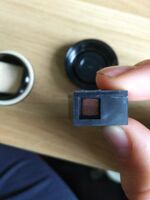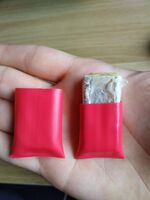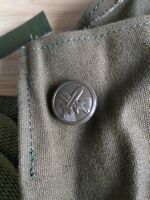The Czechoslovakian CM-4 was designed primarily for civilian use. Due to its sturdy construction and ease of use, the CM-4 platform found use outside of its original intended role of civilian defence - it was also used by police, civil workers and in industry. Many collectors often consider the CM-4 to be one of the most capable and well-designed masks from the so-called Combloc. Two other iterations of the CM-4 exist: CM-4K and CM-4M, these particular models are explained and explored further down the article. Bulgaria bought the license of this masks, creating the PG-1.
Mask overview[]
A CM-4 faceblank is constructed from a whitish-grey rubber that was designed to operate a variety of temperatures - anywhere from -30C° to +50C°.
The wearer's vision was supplied by 2 oval-shaped lenses that are of construction seen on most other masks created by Warsaw Pact countries. Grey crimped metal affixed the lenses in place, with bluish fabric tape underneath to ensure the rubber is not cut by any crimped metal.

Closeup of voice diaphragm
Unlike its predecessor, the CM-3, the CM-4 features a dedicated voice diaphragm. Like the eyepiece assembly, it is made of grey crimped metal and plastic with fabric tape underneath. The CM-4 voice diaphragm assembly is well-made; the wearer's voice is clear and audible.

Closeup of valve assembly
The CM-4 valve assembly is manufactured from grey plastic, during the masks overall construction, the valve assembly is affixed to the rubber via a single metal clamp. A layer of more fabric tape is placed underneath this clamp for proper seal. Over the top of this clamp is a large thick tan rubber band - an extra layer of protection to ensure the clamp does not rust or is exposed to any untoward environmental hazards.
The CM-4 utilises a double exhale valve for added respiratory protection. The outermost exhale valve is protected from damage by a plastic grate which has the word 'CM-4' stamped on it.
The intake valve is threaded for 40mm GOST and is also constructed of the same grey plastic. A grey rubber gasket sits in the intake assembly and ensures that when a filter is threaded on, the assembly creates a gas-tight seal.

Closeup of harness
The CM-4s head-harness is a basic 5-point system. The straps are constructed from a slightly elasticated grey fabric. At the end of each strap is a textured pull-tab made from rubber. This pull-tab is wider than the buckle the straps are threaded through, thus the pull-tabs are also responsible for stopping the straps from coming off the mask. The pull tabs are stitched on.
The back of the head-pad is made from the same textured rubber as the pull-tabs. This textured rubber stops the head-pad from slipping around.
In typical Czechoslovak fashion, the CM-4 sports a brown neck-strap made from fabric. It is stitched to the bottom two buckles on the harness assembly.

Inside of CM-4
Internally, a portion of rubber overhang is folded onto itself to create a peripheral seal on the masks edging. This is one of the major noted advantages the CM-4 gives over the CM-3. The peripheral seal allows for a more comfortable fit and aids in getting a better, tighter seal.
Another noted advantage over the CM-3s internal design is that the CM-4 uses an oral-nasal cup. This is made of the same rubber as the rest of the mask. The cup is held in place by the valve assembly - a small portion of the cups rubber is pinched into the assembly.
The innermost exhale valve is nestled behind the chin-cup.
Kit[]

Closeup of DK-62 dosimeter container

Closeup of DK-62 dosimeter
The CM-4 was issued with a DK-62 dosimeter (not to be confused with the children's protective suit DK-62). Two small circular lids are threaded together to form the DK-62 dosimeters container. Inside is a small black square - this is the actual dosimeter.
The DK-62 is capable of reading and registering exposure to gamma radiation. Its reading range is 20 Roentgens up to a maximum of 800 Roentgens. DK-62 dosimeters were designed to give an accurate reading within 3 minutes of initial irradiation.

Anti-fog soaps for CM-4
DK-62 dosimeters themselves cannot be read. These dosimeters must be used in conjunction with the VDK-62 device in order to ascertain the user's radiation exposure.
CM-4 kits were issued with anti-fog soaps in red plastic sleeves. These sleeves presumably replaced the older Bakelite tubs that Czechoslovakia originally used to issue soaps in.
For those with visual defects, CM-4 masks were compatible with optical inserts.

CM-4 haversack

ČSĽA mark on buttons
The CM-4 kit was issued with a brown-green haversack. Like most haversacks of the era, it was made of stitched fabric. The haversack opened and closed by two plastic buttons which feature a pair of crossed swords (ČSĽA - Československá Ľudová Armáda - mark) on them.
The CM-4 haversack had a shoulder strap made from a similar green fabric. Both sides of the haversack were flanked by a strip of plastic-backed fabric which would be tied together to form a waist tie.
Internally, the CM-4 haversack featured one small pocket near the top. This was used to store anti-fog soap.
Variants and foreign use[]
CM-4K[]
The CM-4 was used in SCBA units made by Czechoslovakian company Meva. The most common of these particular units was called KP-120. The standard CM-4 facepiece was modified by taking the regular plastic valve assembly out and replacing it with an all-steel assembly that would accept the hoses used on the KP-120. These modified CM-4s were given the designation CM-4K.
Meva may have also possibly used the CM-4 platform on their 'Saturn' rebreathers.
CM-4M[]
The CM-4 design was reviewed at some point to allow the respirator to include a drinking system. These CM-4s were given the designation CM-4M. The drinking tube was located next to the valve assembly. Possibly used by Civilní Obrana (civil defence).
Use in Hungary[]
Just after the regime change in 1989 the 75M, 67M and 60M masks were withdrawn from service in Polgári védelem (Civil Defence). Only the 70M stayed as heavy decontamination mask so Polgári védelem needed a new mask for general service. But Medicor, the only gas mask producer in Hungary did not have the capacity to make more 70M masks nor to design a new mask. The easiest solution was to buy masks from a foreign country and because Hungary purchased licenses from Czechoslovakia in the past (like the FVCs-M) the choice was the CM-4. The mask was issued with the MOF-4 filter and a bag similar to the CM-4 and PV-75M bag but it was rubberised. Later in the early 1990s it was mostly phased out by the Biomaszk but it stayed in service until 2001 when Polgári védelem merged together with Tűzoltóság (fire service) to form the Katasztrófavédelem (disaster prevention) and both were replaced by the 3S.
Use in Vietnam[]
Although not much is not known about the usage of this mask in Vietnam, it does see some service within the Rapid Response Force (cảnh sát phản ứng nhanh), Police Unit 113.
Filter[]
Main article: MOF filters
Most CM-4 kits were issued with the MOF-4 filter. The filter came supplied in a protective wrapping of greaseproof paper and an additional protective sleeve made from stapled cardboard.
Filters are supposedly safe, mask even creates a good seal with NATO 40mm filters, but also with Soviet ones (what is exciting, because Czechoslovakia was in Warsaw pact).
Users[]
Gallery[]






